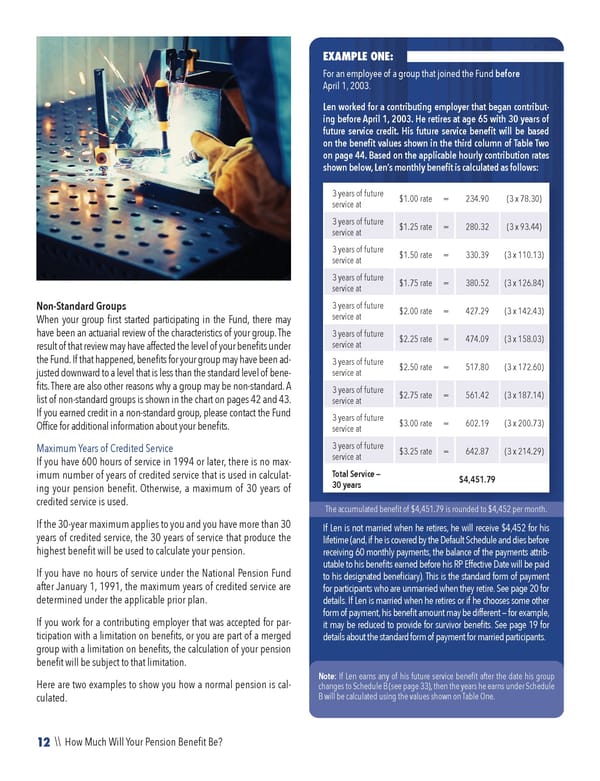12 \\ How Much Will Your Pension Benefit Be? Non-Standard Groups When your group first started participating in the Fund, there may have been an actuarial review of the characteristics of your group. The result of that review may have affected the level of your benefits under the Fund. If that happened, benefits for your group may have been ad- justed downward to a level that is less than the standard level of bene- fits. There are also other reasons why a group may be non-standard. A list of non-standard groups is shown in the chart on pages 42 and 43. If you earned credit in a non-standard group, please contact the Fund Office for additional information about your benefits. Maximum Years of Credited Service If you have 600 hours of service in 1994 or later, there is no max- imum number of years of credited service that is used in calculat- ing your pension benefit. Otherwise, a maximum of 30 years of credited service is used. If the 30-year maximum applies to you and you have more than 30 years of credited service, the 30 years of service that produce the highest benefit will be used to calculate your pension. If you have no hours of service under the National Pension Fund after January 1, 1991, the maximum years of credited service are determined under the applicable prior plan. If you work for a contributing employer that was accepted for par- ticipation with a limitation on benefits, or you are part of a merged group with a limitation on benefits, the calculation of your pension benefit will be subject to that limitation. Here are two examples to show you how a normal pension is cal- culated. EXAMPLE ONE: For an employee of a group that joined the Fund before April 1, 2003. Len worked for a contributing employer that began contribut- ing before April 1, 2003. He retires at age 65 with 30 years of future service credit. His future service benefit will be based on the benefit values shown in the third column of Table Two on page 44. Based on the applicable hourly contribution rates shown below, Len’s monthly benefit is calculated as follows: If Len is not married when he retires, he will receive $4,452 for his lifetime (and, if he is covered by the Default Schedule and dies before receiving 60 monthly payments, the balance of the payments attrib- utable to his benefits earned before his RP Effective Date will be paid to his designated beneficiary). This is the standard form of payment for participants who are unmarried when they retire. See page 20 for details. If Len is married when he retires or if he chooses some other form of payment, his benefit amount may be different — for example, it may be reduced to provide for survivor benefits. See page 19 for details about the standard form of payment for married participants. 3 years of future service at $1.00 rate = 234.90 (3 x 78.30) 3 years of future service at $1.25 rate = 280.32 (3 x 93.44) 3 years of future service at $1.50 rate = 330.39 (3 x 110.13) 3 years of future service at $1.75 rate = 380.52 (3 x 126.84) 3 years of future service at $2.00 rate = 427.29 (3 x 142.43) 3 years of future service at $2.25 rate = 474.09 (3 x 158.03) 3 years of future service at $2.50 rate = 517.80 (3 x 172.60) 3 years of future service at $2.75 rate = 561.42 (3 x 187.14) 3 years of future service at $3.00 rate = 602.19 (3 x 200.73) 3 years of future service at $3.25 rate = 642.87 (3 x 214.29) Total Service — 30 years $4,451.79 The accumulated benefit of $4,451.79 is rounded to $4,452 per month. Note: If Len earns any of his future service benefit after the date his group changes to Schedule B (see page 33), then the years he earns under Schedule B will be calculated using the values shown on Table One.
 2023 NPF Summary Plan Description Page 13 Page 15
2023 NPF Summary Plan Description Page 13 Page 15